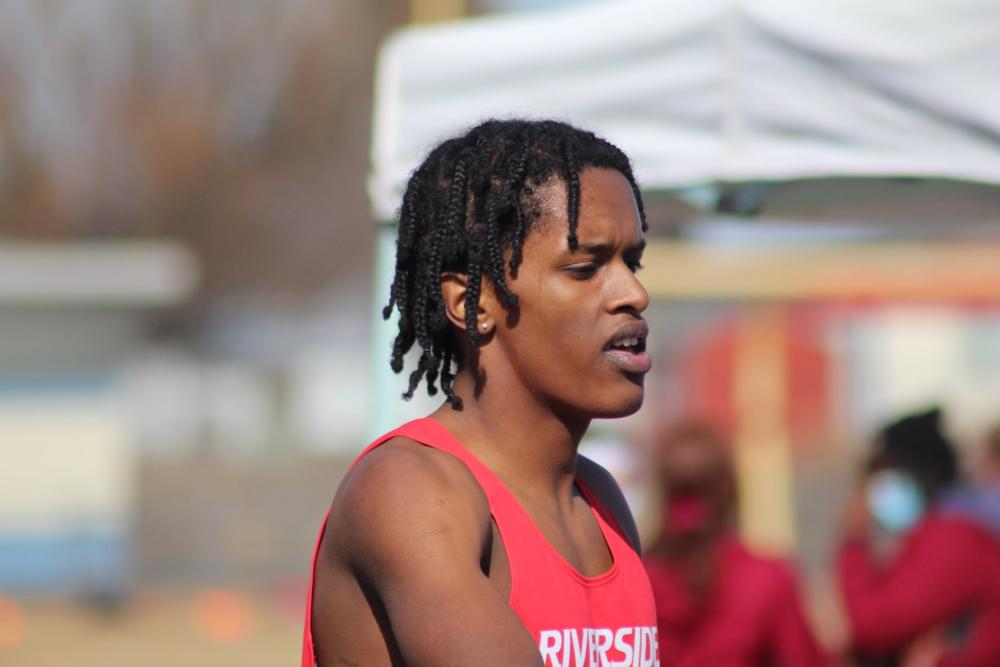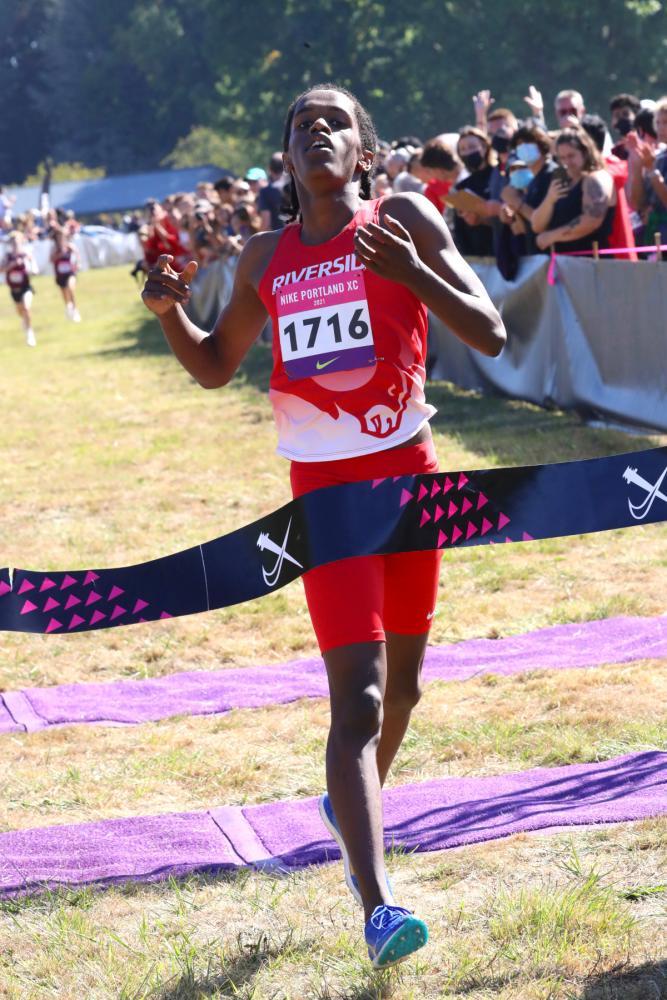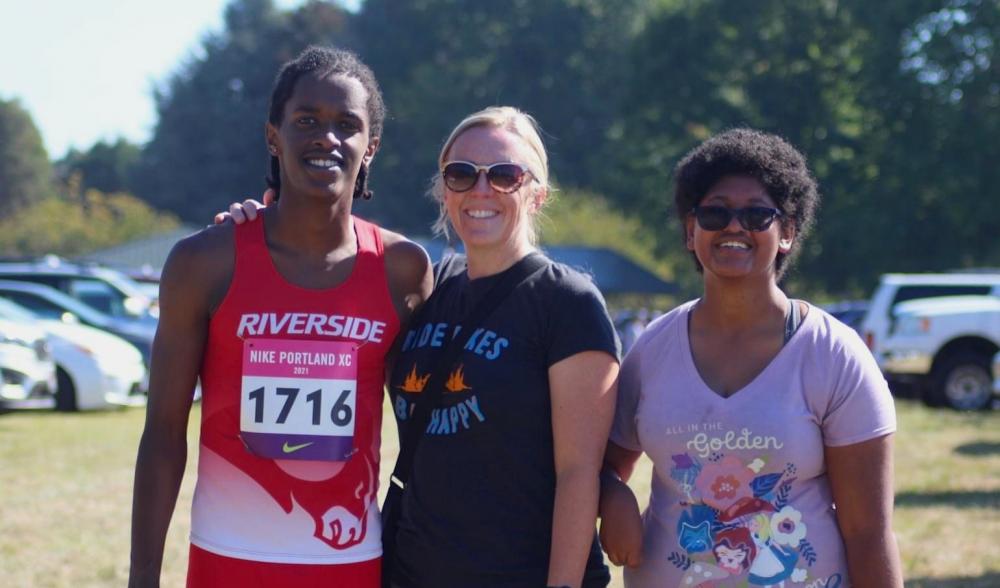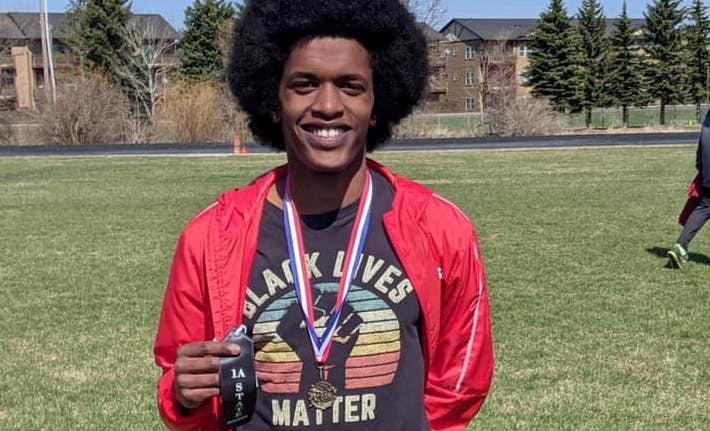Folders |
Jamar Distel Growing Up Fast In A Small Eastern Washington TownPublished by
All the Miles to Jamar DistelA DyeStat story by Dave Devine ___________
Spend some time in Jamar Distel’s bedroom in Chattaroy, Washington. See what you can learn about him. Scan the walls, plastered — as they are in so many teenagers’ bedrooms — with the things that matter most to him. The hints about who he is. The items that define him. Start with the Ethiopian flag, above his bed. The way its distinctive green, yellow and red stripes descend along the crease in the corner. The blue circle at the center with the radiant yellow star. And on the opposite wall, a small tapestry with the Ethiopian alphabet. Further down, a poster of one of the greatest distance runners of all time: Haile Gebrselassie. Below the poster, tucked alongside a cabinet, a sleek silver keyboard. Evidence of a passion for playing piano that has taken a backseat in recent years to Distel’s other major love — running. And the signs of running? Those are everywhere. There are the all-conference awards and the seasonal certificates of achievement. The neatly tacked sheets that document appearances in Washington state meets. There is the haphazard display of race bibs and race numbers and hip numbers and finisher tags. An award for Most Improved Player from a middle school track season. There are encouraging notes from high school teammates and bracelets and keychains and mementos and medals. There’s a pennant from an old course marking that says Finish On Empty. But the most striking piece of real estate in the bedroom is on the wall above the keyboard, where Jamar has hung all the training shoes and racing flats he’s worn in high school. An impressive collection of retired Nikes, New Balances, Asics and Sauconys. Each pair affixed to the wall, toe-to-toe, in tidy columns. Thumbtacks through the lace-holes. It might be a display wall in a running specialty store, if those stores sold sneakers with hundreds of miles on them. Worn soles, scuffed and faded uppers. Dust and mud from the rural Chattaroy roads outside this home, fused to the fabric. Jamar says he wears each pair for somewhere between 400 and 500 miles. Retires them before they start causing injuries. Knowing this — knowing how far he’s come — you can’t help but look at the collection of shoes and wonder: How many miles are hanging on that wall?
When Jamar was an infant, his parents, Julie and Jason, could never have imagined that their son would become a national-class distance runner. They were more concerned with whether he’d learn to walk without assistance. He was adopted from Ethiopia at nine-and-a-half months, joining a household that already bustled with the Distels' two young biological children, Jada and Jakob. “He was really tiny,” Julie recalls. “He wore three-month-old clothes when he was nine months old.” At the state-run orphanage in the Ethiopian capital of Addis Ababa, Jamar had been one of a relatively few healthy infants under the care of the nuns staffing the agency. In a crowded place with many needs, that vigor became something of a liability. “They were so busy taking care of kids with significant needs.” Julie says, “the adoption agency assumes that because he was otherwise healthy and kind of content, they swaddled him and left him in the corner to attend to all these other kids with more intense needs.” It meant Jamar spent his early months wrapped tightly in a blanket, tucked in a crib for most of the day. When he arrived to the Distel home in rural Washington state, the impact of those early days was soon apparent. At nearly 10 months old, Jamar was unable to lay on his belly and lift his head. He couldn’t support weight with his legs. He resisted any attempt to touch or apply pressure to his feet. “He couldn’t bear weight at all,” Julie says, “until he was 18 months old.” There were, of course, pediatrician visits and specialist referrals. Assessments and physical therapy sessions. A lingering suspicion that perhaps his hips had been damaged by the lengthy swaddling. Eventually, Julie says, “he started getting up and walking. And then running. And then he just took off. But we never thought he’d be such a good runner because he had so many problems with his legs early on.” In the midst of helping Jamar through those challenges, the Distels welcomed a second child from the same Ethiopian orphanage to their family — a baby girl this time, six months younger than Jamar, whom they named Jacinda. “Yes,” Jamar says with a laugh, “we’re all ‘J’ names.” Growing up in eastern Washington, the four siblings had plenty of room to explore. Chattaroy is an unincorporated community that sits along U.S. Route 2, about 20 miles north of downtown Spokane. “It’s very small,” Jamar says. “Unless you’re from Chattaroy, you don’t know where Chattaroy is, basically.” There are a handful of neighborhood homes clustered together, he says, all relatively spread out, and then some trailer parks and miles of rolling farmland. Asked whether it’s the sort of town with a single stoplight, he admits he’d never given it much thought. “You know what?” he says. “It actually might be a one-red-light town. I’m pretty sure there’s only one literal, actual stoplight in Chattaroy.” Six miles north on Route 2, where the high school sits, there’s a church, a dental clinic, a U-Haul dealer, two gas stations, and the only fast food place in town. “Our school mascot is a ram,” Jamar says, “but across the street there’s this restaurant that’s also called The Ram. Sometimes, after a football game or a track meet, everyone will go over to The Ram to hang out.” Most of the time, though, he and his friends head to Spokane. “Honestly, there’s not a ton to do up here on a Friday night.” Things didn’t feel quite as mundane to Jamar when he was a child. He remembers days spent roaming the landscape with siblings and friends — “definitely country-type stuff” — shooting Air-Soft guns, exploring local rivers and creeks, goofing off near the stables where the family kept horses at the time, chucking dried horse dung at each other. “Stupid stuff, Jamar says, “just messing around.” When he started school, he was described by teachers as having “a lot of energy.” Some of those teachers wondered if he struggled with attention deficit hyperactive disorder (ADHD). Before long, he so hated the classroom that Julie ended up homeschooling him for a year. It was something she’d never intended, but felt was necessary in this case. Sports provided a different outlet for that same energy. Jamar played a variety of them, with wrestling a particular focus. Running captured his attention as he headed into middle school. Julie was training for marathons and Ironman competitions, so Jamar would ride his bike alongside his mom during her long runs. Jada and Jakob, several years older, both ran cross country and track in high school, which gave their brother another point of exposure. By sixth grade he was on the track team, but lacked the seriousness he’d eventually bring to the sport. He was among the top three or four runners at the junior high, Julie recalls, but by no means a standout. “Running was just kind of a natural thing,” she says, “so he was like, ‘Sure, I’ll try it’”
After adopting two children from Ethiopia, Julie and Jason wanted to make sure the family embraced and celebrated the culture and traditions of the East African nation. “Especially as white parents,” Julie says, “you need to do that. It’s important for kids to know where they came from.” Among the things Jamar learned about his native country was the rich tradition of distance running. As he grew older, he started committing the names to memory — Gebresellassie, Bekele, Kejelcha. He read about them, hung their photos in his room, drew inspiration from their triumphs. “Those guys are the top of the top,” he says. “It’s super inspiring. Just knowing that I’m from Ethiopian blood, it’s awesome.” But that same heritage also gave him an outsized sense of confidence as he entered Riverside High. He assumed that simply being Ethiopian would ensure success as a high school runner. “I just figured, you know, I’m Ethiopian, and Ethiopian guys are fast, so why do I have to try?” He ran hard at times, but was also easily injured. He wasn’t yet a student of the sport, had little appreciation for the benefits of off-season training or the finer details of recovery and strength work. “I eventually realized,” he admits, “that Ethiopians aren’t just fast. They’re so good because they work the hardest, so I started working really hard and everything changed after that.” But even as he was buoyed by a roster of distant Ethiopian standouts, Jamar found his greatest inspiration in a local runner from Chattaroy. Ben Shaw, now a senior student-athlete at the University of Idaho, was a Riverside star when Jamar attended middle school down the street. “He was just the man,” Jamar says, “breaking all the school records. He was probably my biggest idol in running.” Jamar knew that Shaw had graduated with personal bests of 4:15 in the mile, 9:05 for 3,200 meters, 15:31 for 5,000 meters in cross country. He would stare at those marks on the school record board and shake his head in disbelief. Even comparing ninth-grade marks brought him little comfort: Shaw had ripped a 16:16 5k as a frosh; Jamar’s best was 17:19. “It was like, ‘Damn…Ben’s the man,’” Jamar says. “The first two years of high school was trying to catch up to him.” By the end of junior year, every one of Shaw’s records belonged to Jamar. But it was a long process to get there. It included an injury-riddled sophomore cross country campaign followed by a winter of physical therapy revealing a liability that had dogged him since infancy: poor hip strength. Jamar was unable to perform a single-leg bridge with either leg. His glute muscles weren’t firing properly. He was over-striding, stressing his hamstrings and iliotibial bands. The regime of exercises he received from his PT is one he still utilizes today. “I have to do them,” he says, “if I want to be as good as I’m hoping to be.” When the spring of 2020 arrived, Jamar charged into track season with a rebuilt stride and a renewed enthusiasm — “I’d fixed it, I was ready to go,” — only to have the remainder of his sophomore year scrubbed by the COVID-19 pandemic. The disappointment only compounded a series of challenges he’d endured that year. His parents separated the summer before 10th grade, and Jamar had begun spending school weeks with Jason in Chattaroy and weekends with Julie down in Spokane. And then Tim Hart, the longtime Rams head coach with whom Jamar had forged a close relationship, announced he was stepping down at the end of that school year. Jamar envisioned a triumphant final season to give his coach a proper send-off, but that, too, evaporated as the world shut down. Running, he says, “became difficult because everything was cancelled. In the summer, I was training, but I had literally no idea what I was training for — I wasn’t sure if the (cross country) season was going to happen.” It didn’t. Washington’s 2020 high school cross country season was shoehorned into a truncated spring calendar that also included track. Neither "season" concluded with a state meet. “It was super rough,” Jamar says. “Running just became such a job, and it usually doesn’t seem like that.” In the midst of that COVID-cancelled fall season, Kris Daratha came on as head coach at Riverside. An experienced science teacher and distance coach, Daratha had done his own prep running at Mead High, 20 minutes down the road in the suburbs of Spokane. There, he’d spent his freshman year training under longtime Mead mentor Pat Tyson (now at Gonzaga University) before being coached by Tyson’s replacement, Steve Kiesel, for his final three years. Daratha had the chance to witness, up close, the transition from a beloved, longtime coach to a new coach entrusted with carrying on the program’s mantle. He’s taken something of that experience, and lessons from both head coaches, plus his father, Scott, another influential coach in the area, into his own work with Jamar and the Riverside team. The results of that work first became evident last spring. Jamar ran undefeated through a league-only cross country season, culminating with a 15:12 victory in a “virtual” 1A state meet organized by the Washington state coaches association. Track was also restricted to league meets due to COVID, but Jamar traveled to a pair of high performance meets in western Washington in April and May to face some of the top runners in the region. At those meets, he dropped new personal bests of 4:12.47 for 1,600 meters and 9:04.97 for 3,200. “I’ve never met somebody,” Daratha says, “who has more of that inner drive, where he knows what he needs to do and he just goes and gets it done.” The coach has worked with Hart, who continues to teach at Riverside, to craft a training plan that will deliver on the lofty goals Jamar harbors for the remainder of this year. He’s already recorded big wins and fast times across a range of distances this fall: 12:17 for 2.5 miles at the Highlander Invite, 14:48 for 5,000 in a victory at Nike Portland XC, and 14:13 for 3 miles and a course record at the Richland Invitational. On November 6, he’ll shoot for his first in-person WIAA 1A state cross country title in Pasco, and then hopes to show he’s more than simply a “small school, 1A guy” when he travels to Huntsville, Ala., in December for the RunningLane Cross Country Championships. For a former wrestler and current fan of mixed martial arts — Jamar and his father watch all the MMA pay-per-views together — the prospect of punching above his weight class is something that sustains him. “It’s a huge part of my motivation,” he says. “Trying to prove you don’t need a big program — 150 kids on your team or all the extra stuff — if you just have the passion and desire. I don’t need seven or eight dudes to motivate me to run. Something I take some pride in, is that I have the desire and will to push myself every day.”
They were just kids, maybe 10 or 12 years old. They saw Jamar coming, halfway through his Sunday long run. He saw them too, could read the body language. See how they badgered each other, daring one kid or another to do something. Say something. Spit out a slur. And how one kid finally did, calling Jamar the n-word as he was running past. And then how they were all saying it. Calling after him. The n-word. Hard ‘R’. This isn’t some indelible childhood memory for Jamar, a hard lesson that cemented the challenges he would face as a Black child growing up in an overwhelmingly white community — this was two weeks ago. When he later recounted the story to his mom, he told Julie he ignored the taunts and decided to grind through the rest of his 14-miler. He wasn’t sure if that was the right thing to do or not. It’s the kind of question, unfortunately, that he wrestles with often. What to do? How hard to push back? When to speak up. At Riverside High, he’s the Associated Student Body (ASB) class president. His name regularly appears in the morning announcements for his athletic accomplishments. Photos from his races scroll across TV monitors in the hallway. He’s likely the best runner to ever come from this community. He’s a role model. A top student. A compassionate big brother to Jacinda, who has cerebral palsy and leans on Jamar for assistance at home and school. He’s a Division 1 prospect with a verbal commitment to the University of Washington. And yet, on a routine run through backcountry roads, he’s called the n-word by neighborhood kids. It’s the type of infuriating dichotomy that Julie says her son has been aware of, and preparing for, his entire life. The reality that exceptionalism, in the end, guarantees nothing if you’re Black in America. And that even if he were none of those things — not the star athlete, the student body president, the excellent student — he would still deserve to be treated with the same humanity everyone deserves. Racism, he’s learned, is a reality he can’t run from, no matter how many miles he puts in. “He obviously stands out because of the color of his skin,” Julie says, “so people know who he is when he walks in the door. There’s like three Black kids, I think, at his high school, so there’s good and there’s bad with that.” She mentions how other students ask to touch his hair. Pat his afro. Handle his braids. How people ask about his commitment to the Black Lives Matter movement, the protests he’s attended. The pickup trucks with Confederate flags in the local parking lots. “He’s very patient,” Julie says, “and he tries to educate, but it’s really hard for a teenager to have to do that.” She can’t help but worry, too, about her son’s solo runs on those country roads. She knows there are plenty of gun owners in rural Washington, many of whom use guns for legitimate hunting purposes. “But that still makes me nervous,” Julie says. “That someone will see a strong Black man running through the neighborhood, and think he’s trying to steal something or…” She trails off. “I worry about that a lot.” Jamar worries, too, but he tries to bend those concerns, and his experiences as a young Black male in an overwhelmingly white community, toward education and action. He’s attended several protests and marches connected with the Black Lives Matter movement, part of the national reckoning that emerged after George Floyd’s murder by Minneapolis police officers in May 2020. Jamar’s passion for the cause, and his insistence on dialogue over confrontation, has led him to initiate his own conversations with law enforcement when opportunities arise. Julie remembers a meet in Medical Lake last year at which a uniformed police officer was present, cheering for his child. Jamar waited until the competition was over, pulled on his BLM t-shirt, and approached the officer with a handshake. “I’m seeing him over there,” Julie says, “and I’m going, ‘Why is my son talking to a cop?’” When she asked him about it afterward, Jamar said he’d been curious about the officer’s thoughts on Black Lives Matter, wanting to see if they could have a civil conversation. Reach some kind of understanding. “He said that’s what we should all be doing, having conversations,” Julie remembers. “And to me, that’s Jamar in a nutshell.”
Still, the question: How many miles are hanging on that bedroom wall? There are the running shoes, of course, thumbtacked in their neat pairs, but that’s just the beginning. Merely one way to measure. What about the race numbers? Or the racing spikes that hang below the trainers? There are miles on those, too. And then what about the certificates and the handwritten notes? The posters and stickers and handmade keychains? The Most Improved Player award from back in middle school, when running was brand new and Ben Shaw was the measuring stick for greatness? Miles in those mementos, as well. And what about the Ethiopian flag? How do you measure the distance from that flag to those thumbtacked running shoes on the opposite wall? It’s perhaps a few feet? Eight thousand miles? A lifetime? Cramped crib to state meet starting line. There are all the miles that made him a hero in the high school hallways. The ones that put his name in the morning announcements. Into the DyeStat Top 30. But there are also the miles he ran on that unsuspecting Sunday morning, only to hear a racial epithet hurled by neighborhood kids. And the miles on the way home afterward, mulling the incident in his head. Miles of indecision, second guessing. Resolve and determination. All those miles are hanging in this room, too. Some of the miles are heavy, some are light. And every evening when he goes to sleep, Jamar is surrounded by the memories of those miles. Reminders of where he’s been and where he hopes to go. Dirt roads. District champs. The state meet. RunningLane in Alabama. Track season in the spring. How many miles? Truth is, there’s too many to count. The walls in the bedroom are already crowded; the real estate is running low. But right now? Right now, there’s still room for a few more shoes. |










